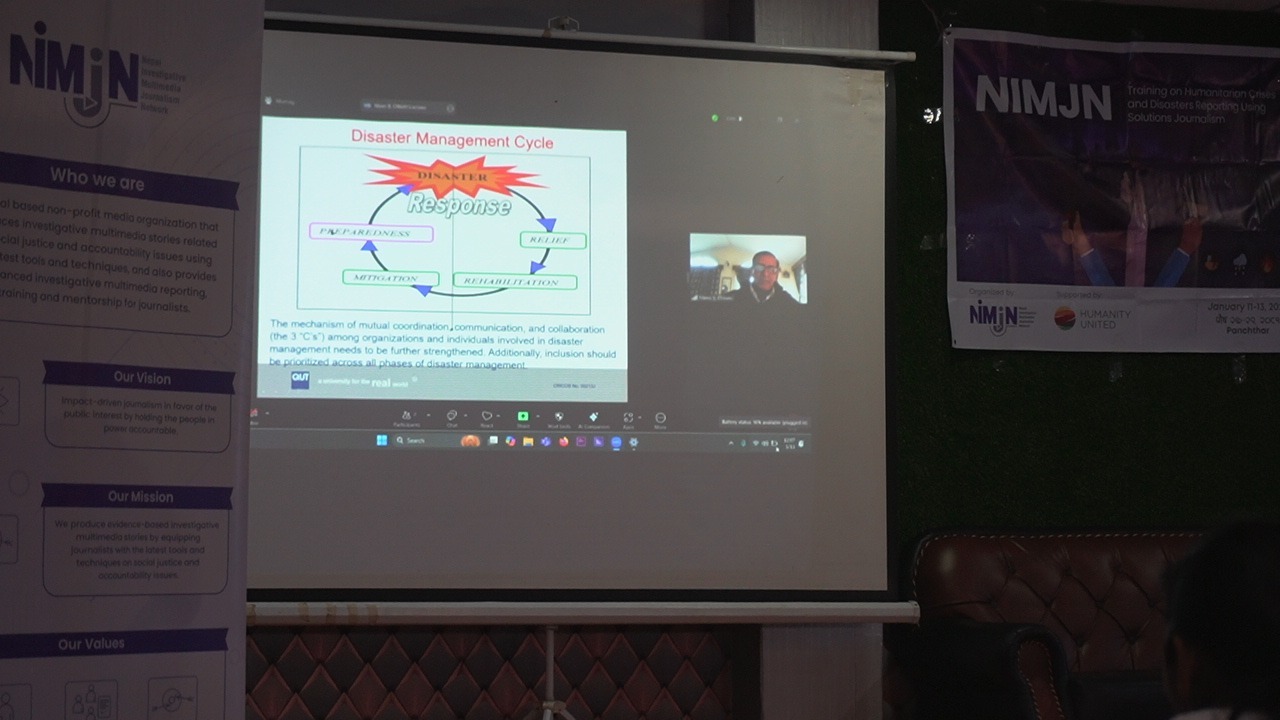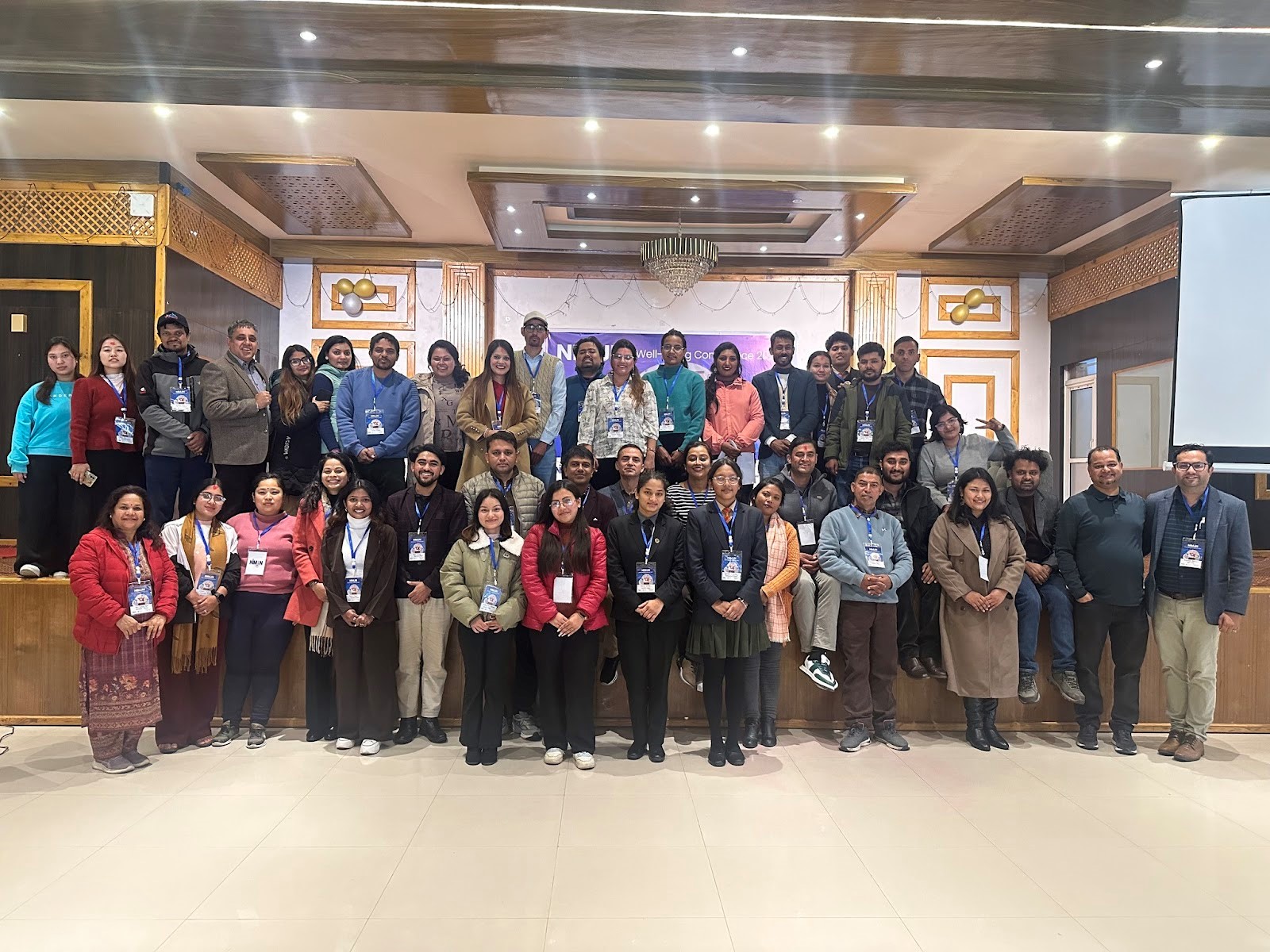The Nepal Investigative Multimedia Journalism Network (NIMJN) successfully organized its second training on Humanitarian Crises and Disaster Reporting Using Solution Journalism in Phidim, Panchthar. Twenty-five journalists from various districts of Koshi Province participated in the training that took place from January 11 to 13, 2025. The three-day residential training provided journalists with the latest technical, practical, and theoretical reporting skills on reporting disasters and crises. The training was supported by Humanity United. The first training was organized in Godavari, Lalitpur.
The training consisted of sessions ranging in topics from introduction to investigative reporting to solutions reporting, understanding humanitarian crises and disasters in Nepal to reporting on climate-induced disasters, generating hypotheses to safety and ethics of journalists, multimedia reporting to data-storytelling, experience sharing by NIMJN fellows on disaster reporting stories to maintaining mental well-being as a journalist while disaster reporting.
NIMJN's Chief Editor, Rajneesh Bhandari, led the sessions on investigative reporting, solutions journalism, multimedia storytelling, and mobile journalism. He showed the best examples of reporting with photos, video, graphics, and data.
Meen Bahadur Paudyal Chettri, Ph.D., from the Nepal Centre for Disaster Management, led the session on the theory and practice of disaster management, types of disasters, recent trends, disaster risks in Nepal, and practical tips for journalists covering the disaster.

Trainer Dinesh Regmi led a session on disaster-induced displacement and migration. In this session, he clarified the concepts of displacement and migration, providing various examples and personal experiences. He also highlighted the importance of reporting on disaster-induced displacement and migration.
Sunita Chaudhary's session focused on prioritizing targeted populations in the context of disaster and humanitarian crises. She emphasized that women, children, and elderly people are often the most affected and vulnerable in such scenarios and shared the importance of being mindful of intersectionality in disaster reporting.
Participants visited the flooding-affected areas near Hewa Khola and Feme Khola on the second day.
Prof. Dr. Nirmal Lamichhane from the Department of Psychiatry and Mental Health at Gandaki Teaching Hospital discussed mental well-being and provided strategies for journalists to manage stress while reporting on humanitarian crises and disasters. He highlighted several factors that impact journalists' mental health, such as low pay, deadline pressure, external threats, professional insecurity, and trauma related to disasters.
At the end of the session, Dr. Lamichhane taught stress management techniques such as breathing exercises, stretching, and meditation.
NIMJN Fellows Ruma Rijal and Alina Rai shared their experiences, including the challenges and lessons learned in producing in-depth investigative stories on disaster issues in the era of social media. They highlighted that reporting on disasters and humanitarian crises is both sensitive and challenging, and that the rise of social media and digital transformation adds to more challenges.
On the second day, multimedia editing and data storytelling, including the use of online tools, were organized. Participants edited videos taken during the field visit to Hewa and Feme Khola using VN.
On the final day of the training, videos produced by fellows were showcased. Five participants will be awarded fellowships to report on disasters and crisis issues using solutions journalism. They will be selected based on their story pitches and ideas.
Here are some excerpts from participants:
Earlier, I had attended a training on human trafficking and human rights organized by NIMJN. This training on reporting humanitarian crises and disasters using solution journalism is different because it incorporates solution journalism, which I find pretty interesting. This is a great way to practice journalism, as it allows us to report on issues or problems and explore potential solutions that should be shared with the public and stakeholders. The training focuses not just on raising awareness of problems but also on finding solutions in the context of humanitarian crises and disasters.
- Alina Rai, Sunsari
During the field visit, we visited disaster-affected areas. We learned how to capture and collect video footage from there, and we also edited the videos using mobile phones. Mobile phones are an easy and accessible tool for effective, in-depth investigative journalism. The field visit and multimedia training were very interesting for me. In addition to the multimedia content, I found investigative and solutions journalism very engaging. I hope NIMJN continues to provide such valuable training in the future.
- Bishal Kumar Mandal, Morang

